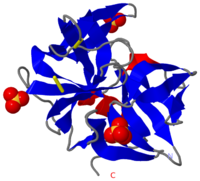Chymotrypsin
From Proteopedia
| Line 5: | Line 5: | ||
[[Chymotrypsin]] (Chy or α-Chy) is a digestive enzyme containing an active serine residue, which helps to digest proteins in our food. Other related proteases are crucial for blood clotting ([http://www.ncbi.nlm.nih.gov/bookshelf/br.fcgi?book=stryer&part=A1378&rendertype=figure&id=A1401 thrombin and other proteases]), for the AIDS virus metabolism ([http://www.proteopedia.org/wiki/index.php/Hiv_protease HIV protease]) and for many other processes relevant to human health and agriculture. Chymotrypsin cleaves peptide bonds of proteins where the amide side of the bond is an aromatic amino acid like tyrosine, phenylalanine or tryptophan. Bovine Chy is found in 2 forms: A and B. The 2 forms have different proteolytic characteristics. The image at the left is the crystal structure of chymotrypsin from ''Cellulomonas Bogoriensis'' ([[2ea3]]) with sulfate ions.<ref>PMID:3555886</ref><br /> | [[Chymotrypsin]] (Chy or α-Chy) is a digestive enzyme containing an active serine residue, which helps to digest proteins in our food. Other related proteases are crucial for blood clotting ([http://www.ncbi.nlm.nih.gov/bookshelf/br.fcgi?book=stryer&part=A1378&rendertype=figure&id=A1401 thrombin and other proteases]), for the AIDS virus metabolism ([http://www.proteopedia.org/wiki/index.php/Hiv_protease HIV protease]) and for many other processes relevant to human health and agriculture. Chymotrypsin cleaves peptide bonds of proteins where the amide side of the bond is an aromatic amino acid like tyrosine, phenylalanine or tryptophan. Bovine Chy is found in 2 forms: A and B. The 2 forms have different proteolytic characteristics. The image at the left is the crystal structure of chymotrypsin from ''Cellulomonas Bogoriensis'' ([[2ea3]]) with sulfate ions.<ref>PMID:3555886</ref><br /> | ||
*'''γ-Chy''' is a covalent acyl adduct of α-Chy. | *'''γ-Chy''' is a covalent acyl adduct of α-Chy. | ||
| + | *'''Chymotrypsinogen''' is nonactive precursor of α-Chy. | ||
Some additional details in<br /> | Some additional details in<br /> | ||
*[[Molecular Playground/Chymotrypsin]]<br /> | *[[Molecular Playground/Chymotrypsin]]<br /> | ||
Revision as of 10:01, 3 June 2024
| |||||||||||
Contents |
Mechanism
The hydrolysis occurs in two steps. First, the peptide bond with the C-terminal part of the substrate is replaced by an ester bond to the active site serine. Second, the covalent intermediate is hydrolyzed by water, releasing the N-terminal part of the substrate as carboxylic acid. Both steps occur via a tetrahedral intermediate containing an oxyanion that is stabilized by hydrogen bond donors lining the so-called oxyanion hole. Throughout the reaction, active site residue histidine 57 acts as base or acid to deprotonate nucleophiles or protonate leaving groups, respectively. The following 5-minute video shows the mechanism step by step.
3D Structures of Chymotrypsin
References
- ↑ Appel W. Chymotrypsin: molecular and catalytic properties. Clin Biochem. 1986 Dec;19(6):317-22. PMID:3555886
Further reading
You can learn more about chymotrypsin structure, function and regulation in this publicly available chapter of the Biochemistry textbook by Berg, Tymoczka and Stryer.
Proteopedia Page Contributors and Editors (what is this?)
Michal Harel, Karsten Theis, Alice Harmon, Alexander Berchansky


